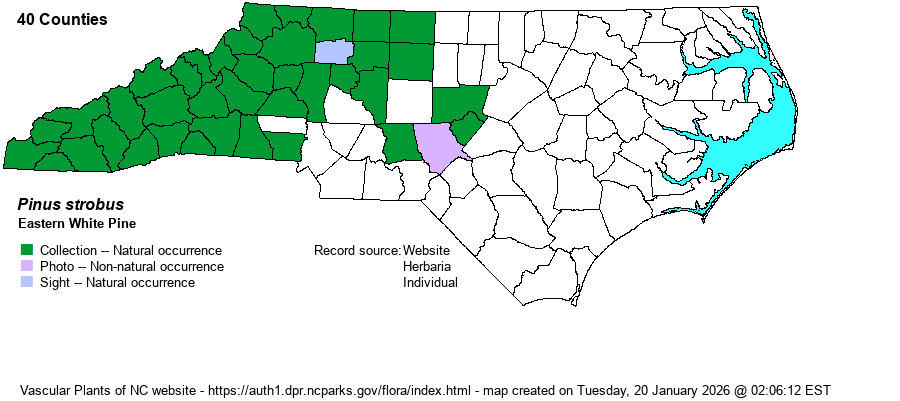| Author | L. | |
| Distribution | Throughout the Mountains and the Piedmont foothills and lower elevations in these western counties. Disjunct to the southeastern Piedmont (a small area of Chatham and Lee counties), by the Uwharrie River in Montgomery County, as well as a few scattered counties elsewhere in the central Piedmont. As this species is frequently planted, some records in the Piedmont are likely of escaped individuals. Frequently planted in Moore County, but no established escapes have been documented.
A very wide range in the northeastern part of the continent, from Newf and N.S. to southeastern Man. south to northern GA and AL; mainly avoids the lower Piedmont and all of the Coastal Plain south of DE.
| |
| Abundance | Common to very common in the Mountains and foothills; rare and local as far into the Piedmont as Chatham and Lee counties. | |
| Habitat | This pine occurs in a great array of soils and topographic settings, with no obvious preferences – though it shows a slight preference for more humid or cooler microclimates (than our other pines). Typically it is found on mesic soils of slopes, ravines, and creeksides; but it also can be numerous on dry or rocky slopes and sunnier habitats. In the Chatham and Lee counties area, along the Rocky and Deep rivers, it requires a cool microclimate in shaded ravines and mainly north-facing slopes. |
| Phenology | Pollen is set in April, and cones mature in August and September. | |
| Identification | This is a well-known and easily identified tree species, it being a large tree when fully grown, often reaching 100 feet tall. It is very unlike our other pines, it being called a “soft” pine – the branches are whorled (several coming off the trunk at the same height – one whorl per year), the pale blue-green needles are in fascicles of 5 (usually), and the cones are quite long (about 4.5-5 inches) and narrow, and the cones are free of prickles. In fact, at a distance a White Pine may look more like a hemlock, spruce, or fir than it does any other pine in the state. The main identification issue is deciding whether occurrences in the central or eastern Piedmont are natural or not, as the species is so frequently planted in yards and towns. Because of the death of most Eastern Hemlocks (Tsuga canadensis) in our mountains in the past 15 years, the much needed presence of White Pines along our mountain streams and coves may be critical for maintaining some integrity of the cool microclimate and shade needed for fish, salamander, and other plant and animal diversity. | |
| Taxonomic Comments | None
| |
| Other Common Name(s) | Often simply called “White Pine” in the East, but as there is the equally common Western White Pine in our western states, references need to use a modifier name to distinguish the two. Other names include Northern White Pine, Weymouth Pine, and Soft Pine. | |
| State Rank | S5 | |
| Global Rank | G5 | |
| State Status | | |
| US Status | | |
| USACE-agcp | FACU link |
| USACE-emp | FACU link |

